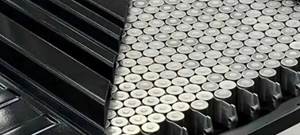Fabrum, AMSL Aero and Stralis Aircraft successfully fill LH2 composite aviation tanks
Australian/New Zealand team makes significant step forward in the transition to zero-emission aviation.
Source | Fabrum
“Now, we can provide evidence to the world that liquid hydrogen composite tanks are a reality … we’re making them.”
A team of New Zealand and Australian companies developing and deploying liquid hydrogen (LH2) technologies to enable Australasia’s first hydrogen (H2)-electric flights has made a significant step forward in the transition to zero-emission aviation. They successfully filled composite tanks with LH2 produced and stored on-site for the first time at an international airport in preparation for pre-flight testing. This team includes:
- (Christchurch, New Zealand), developer of zero-emission transition technologies, including composite LH2 tanks.
- (Sydney, Australia), developer of the Vertiia H2-electric vertical takeoff and landing (eVTOL) aircraft.
- (Brisbane, Australia), developer of high-performance, low-operating-cost H2-electric propulsion systems.
Fabrum designed and manufactured the advanced composite LH2 tanks for the aircraft companies AMSL Aero and Stralis Aircraft. The refueling was successfully completed at Fabrum’s dedicated LH2 test facility at Christchurch Airport, developed in partnership with the airport at its renewable energy precinct.
The companies are demonstrating that LH2 fuel is a credible alternative for the aviation industry. The testing event highlighted several LH2 technologies — including Fabrum’s triple-skin onboard tanks, featuring what is reported to be “groundbreaking” composites manufacturing techniques and the culmination of more than 20 years of R&D in cryogenics and composites. Fabrum’s LH2 tank technology provides enhanced thermal insulation and fast refueling compared to conventional double-skin tank designs — delivering up to 70% faster refueling times and an 80% reduction in boil-off losses.
AMSL Aero will install these tanks on its Vertiia aircraft for long-range flights, enabling it to achieve optimal range, payload and speed. In addition, Stralis Aircraft’s lightweight H2-electric propulsion system will be powered by LH2 from Fabrum’s cryogenic tanks, which are mounted on the wings of Stralis’ fixed-wing test aircraft. Stralis expects its H2-electric propulsion system will enable travel up to 10 times further than battery-electric alternatives and save 20-50% on operational costs compared to fossil fuel. Its first H2 test flight is expected to take off in Australasia within 6 months.
“Our lightweight composite tanks, together with our H2 liquefier and refueling systems, are critical enablers for H2-powered flight,” explains Christopher Boyle, managing director of Fabrum. “By bringing all the elements together for the first time on-site at an international airport — producing, storing and dispensing LH2 into composite aviation tanks as a fuel — we’re proving that LH2 technologies for aircraft are now available, and that H2-electric flight will soon be a reality in Australasia.”
Since its inception, Vertiia was designed to be powered by H2 for long-range, cargo and passenger operations. “It must be as light as possible to achieve its 1,000-kilometer range, 500-kilogram payload and 300 kilometer/hour cruising speed,” Dr. Adriano Di Pietro, CEO of AMSL Aero, explains. “LH2 is the lightest zero-emission method of storing energy for long-distance flight; no other technology currently comes close. We often get asked, ‘You are flying Vertiia and are developing an end-to-end H2 system, but what else needs to happen to make Vertiia fly on LH2?’ With Fabrum we have demonstrated the key steps in that process: from producing LH2, to filling our ground transport container, then filling the tanks that we will install to our aircraft before our first LH2 flights next year. This is a major milestone.”
"It’s fantastic to see more of Fabrum’s H2 technologies unveiled and tested,” adds Bob Criner, CEO of Stralis Aircraft. “We are working with Fabrum to develop onboard tanks for our fixed-wing test aircraft to supply H2 to our H2-electric propulsion system. We’re excited to see Fabrum’s H2 fuel dispensing systems for these onboard tanks proven out in testing. This is a vital step toward our first LH2 test flights.”
These H2 advancements stem from strong industry collaboration aimed at accelerating zero-emission aviation. Fabrum, AMSL Aero and Stralis Aircraft are members of the Hydrogen Flight Alliance in Australia, which is advancing the development of H2-electric flight. AMSL Aero was recently awarded a grant from the Australian Government Department of Industry, Cooperative Research Centres Projects (CRC-P) Program for a “Liquid Hydrogen Powered Aircraft for Regional and Remote Australia” project, with Fabrum among the collaborators. Stralis Aircraft and Fabrum have also received support from Ara Ake, New Zealand’s future energy center, to fast-track H2 technology for Australasia’s LH2-powered flight.
Related Content
OVERLEAF tackles thermoplastics, open cell insulation, sensors and testing for LH2 tank
Newsletter #4 gives latest status on EU project’s work toward thermoplastic composite tanks with 40% storage density of cryogenic hydrogen for future zero emissions aircraft.
Read MoreAirbus outlines next-gen single-aisle aircraft technology focuses, revised ZEROe project roadmap
Outlined technology bricks — including foldable wings, more efficient engines and propulsion and composite materials — could support a planned single-aisle next decade, plus Airbus’s renewed commitment of a commercially viable H2 aircraft.
Read MorePlant tour: Hexagon Purus, Kassel, Germany
Fully automated, Industry 4.0 line for hydrogen pressure vessels advances efficiency and versatility in small footprint for next-gen, sustainable composites production.
Read MoreComposites end markets: Batteries and fuel cells (2024)
As the number of battery and fuel cell electric vehicles (EVs) grows, so do the opportunities for composites in battery enclosures and components for fuel cells.
Read MoreRead Next
AMSL Aero secures $3 million to progress Australian LH2 aviation
Project goals include designing LH2 refueling systems, validating power distribution and fuel measurement in flight, and gathering evidence to support future national regulatory frameworks.
Read MoreAMSL Aero makes H2 testing milestones for hybrid Vertiia eVTOL
Bankstown and Wellington fuel cell work has helped to verify Vertiia’s powertrain while also feeding electricity into the airport grid, bringing the composites-intensive Australian aircraft closer to flight.
Read MoreCeramic matrix composites: Faster, cheaper, higher temperature
New players proliferate, increasing CMC materials and manufacturing capacity, novel processes and automation to meet demand for higher part volumes and performance.
Read More












